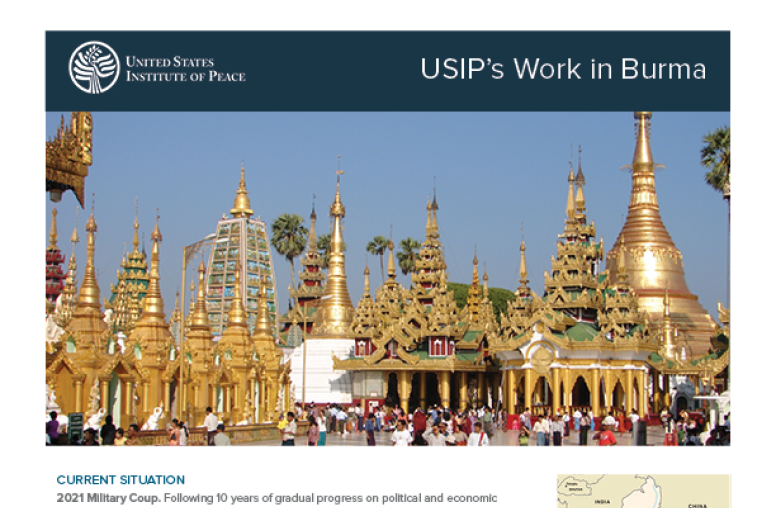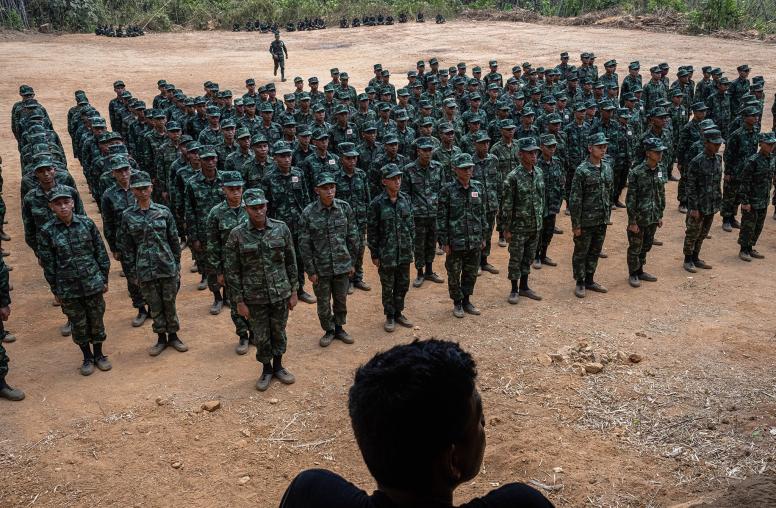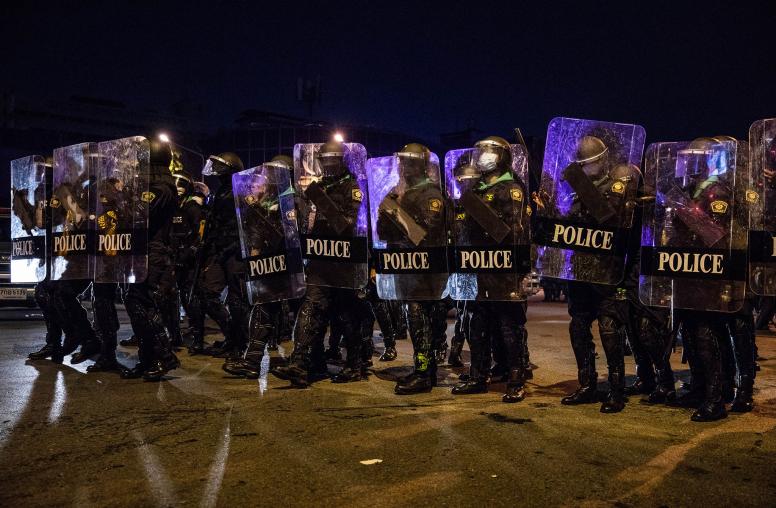China and Myanmar’s Ousted Leaders: Mixed Signals, Cold Interests
Beijing keeps the National League for Democracy on a string while closing deals with the country’s new dictatorship.
Over the past two months, China has sought to resuscitate its relations with Myanmar’s National League for Democracy (NLD), the deposed party of Aung San Suu Kyi. Many analysts speculate the move reflects eroding confidence on Beijing’s part in the military junta’s staying power. But does it? While interpreting China’s delicate dance with Myanmar’s dictators is complicated at best, these are the facts: China’s expanded NLD contacts have come with zero material support; in contrast, since August, Beijing has engaged in economic, diplomatic and humanitarian activities that strengthen its ties with — and directly benefit — the military junta. Likewise, China’s party-to-party diplomacy has sought to moderate and restrain the NLD, rather than support, it.

Before the February 1 coup, China was among the NLD’s top international partners. From 2015 until early 2020, when China closed its borders due to COVID-19, NLD leader Aung San Suu Kyi made five trips to China and met five times with Chairman Xi Jinping, including hosting the Chinese leader in Myanmar. On that visit, Xi announced that he would work with the NLD leadership to “jointly create a China-Myanmar community of shared destiny.” Following the coup and Commander-in-Chief Min Aung Hlaing’s kidnapping of the democratically elected leadership, China immediately dialed back interactions with the NLD. A series of letters and requests to China from the party, and from the parallel underground government it established in April, went unanswered for months.
Low-level outreach from the Chinese Embassy, meanwhile, focused on demanding that Myanmar’s deposed civilian leaders help protect China’s economic interests rather than on creating goodwill. It was only in July, following a congratulatory letter from the NLD to the Communist Party on its 100th anniversary, that Beijing finally broke the silence. This did little to change China’s direction with the military, though. In the following weeks, China advanced working-level ties with the junta’s State Administrative Council, inviting it to join key bilateral and multilateral meetings.
While China claimed that it had dissuaded Min Aung Hlaing from dissolving the NLD, it failed to acknowledge any of the NLD’s actions over the previous eight months: its declaration on abolishing the unpopular constitution, its creation of a platform for dialogue with ethnic armed groups, or its bid to make progress in relations with the Rohingya.
The Chinese government asserts that “China-Myanmar friendship is open to all people of Myanmar,” and claims to maintain robust relations with the NLD, but a close look at Chinese stakeholders’ actions over the past three months paints a very different picture.
This raises the fundamental question: What are China’s true intentions with respect to the NLD and the broader Myanmar opposition to military rule?
Trains, Connections, and Industrial Zones
Following China’s decision in early August to draw closer to the junta’s State Administrative Council (SAC), local and national Chinese officials quickly pushed forward initiatives that deepened economic ties.
At the center of this activity was Lincang City, located in China’s Yunnan Province across the border from Myanmar’s Kokang Special Autonomous Zone (SAZ) and home to a massive cross-border economic cooperation zone occupying 3.47 square kilometers (2.2 miles).
Chinese government documents show the zone had accumulated more than $31 billion of investment by the end of 2020. The primary selling point for its mostly Chinese investors is the access it provides to the Indian Ocean through Yangon Port and the planned Kyauk Phyu Port project in Myanmar’s southern Rakhine State.
New Corridors
In late August, Lincang finalized an agreement with the junta’s commercial authorities to open the trade route to Yangon — dubbed the China-Myanmar New Corridor. It links a new, 201-kilometer railroad line that starts at Lincang and ties into the Chinese national rail system with a highway — completed in May — that goes to Myanmar’s largest city Yangon and the port.
The inauguration of the corridor corresponded with Lincang’s hosting of the second China-Myanmar Border Trade Expo, which attracted participation from over 257 Chinese companies, more than four times the number that came in 2019. High-level Communist Party officials attended the Expo, showering the junta’s Ministry of Commerce with praise for its role in advancing trade connectivity.
In September, neighboring Guangxi Province followed Lincang’s lead, striking new business deals with the junta through a separate China–ASEAN Expo. The Expo hosted an exhibition from a major Chinese-backed industrial zone in Mandalay and saw the signing of significant deals on e-commerce between Chinese companies and Myanmar businesses close to the junta.
The same month, one of China’s largest state-owned enterprises signed a deal to begin field survey work for the coveted Kyauk Phyu Deep Sea Port Project.
Mutual Political Support
International media have argued that China signaled reluctance to fully embrace the junta by cutting a deal with the United States blocking the generals’ chosen delegate from taking Myanmar’s seat at the United Nations. Should this be understood as a Chinese concession to the NLD? Not when full measure of the deal is taken; it leaves the current representative, an outspoken, pro-NLD holdover, effectively muzzled.
Other key political developments reinforce the perception that an emerging alliance between China and the SAC goes beyond economics.
First, in early September, the SAC Ministry of Health stated its support for China in the controversy over the origins of COVID-19. Beijing gave the announcement prominent coverage on state television and the Chinese Foreign Ministry highlighted Myanmar’s support, helping to legitimize the junta.
Second, as the U.N. Human Rights Council convened in mid-September in Geneva, Myanmar was among 40 countries signing a Chinese-led statement condemning foreign interference justified by “human rights or democracy.” This is especially significant. China has argued since the coup that “Western forces” are behind much of the subsequent violence and voiced repeatedly the need to “prevent foreign interference” in Myanmar.
Third, just two days after the announcement of the U.N. deal, a Chinese Foreign Ministry press statement emphasized the role Myanmar had assumed in August of coordinator for the China-ASEAN relationship, and Beijing’s desire to work with Myanmar to enhance China-ASEAN relations. The statement, which made no mention of the political crisis, also stressed China’s desire to continue implementation of the China-Myanmar Economic Corridor, clearly a reassurance to its southern neighbor after making the representation deal at the United Nations.
The Reality of Party-to-Party Engagement
The Chinese Communist Party’s resumption of ties with the NLD followed a letter the NLD sent commemorating the CPC’s 100th anniversary on July 1. The CPC’s International Department acknowledged the message in a press release on July 9, listing the NLD first among the five Myanmar political parties that offered congratulations — a list that included the military’s affiliated party. The CPC followed up by inviting the NLD’s point person on China relations, Bo Bo Oo, to join by video a seminar held for South and Southeast Asian political parties ahead of the China-ASEAN Expo. While the military’s Union Solidarity and Development Party was also invited, video of the event on Chinese state media featured only the NLD.
Though China has made clear it opposes any steps toward dissolving the NLD, there is no indication of Chinese warmth for the parallel, NLD-dominated National Unity Government (NUG).
To the contrary, Chinese scholars have argued since the NUG was established that Aung San Suu Kyi and the other detained leaders of the NLD might not agree with the direction it has taken and on that basis question the NUG’s legitimacy.
The CPC has also warned NLD leaders to avoid revolutionary or destabilizing activity. Instead, it has encouraged the NLD to distance itself from the NUG, which has declared a “people’s defensive war.”
Meanwhile, Chinese state media has been quick to echo and amplify junta propaganda about the coup and to reject any steps taken by the NUG. For example, a critical NUG move was its declared annulment of the 2008 constitution, which let the military retain significant powers. Many ethnic armed organizations and civil society figures strongly support the NUG stance. China’s official position, however, calls for ending post-coup violence through a political solution based on that constitution.
Risky Business
A closer look at China’s position that “China-Myanmar friendship is open to all people of Myanmar” offers additional clues to Beijing’s calculations vis-a-vis the NLD.
Beijing remains concerned about the risks to its strategic investments in Myanmar posed by growing anti-China sentiment. Since March, Chinese projects have been targeted by protesters and people’s defense forces and have suffered tens of millions of dollars in damages.
Keeping lines open to the NLD may ease China’s relationship with Myanmar’s people, who largely continue to support the party. It also helps deter the military from any sudden termination of the NLD that would provoke popular backlash and further destabilization.
But China is playing a complicated game. Maneuvering that offers the NLD a veneer of legitimacy in exchange for keeping a distance from the broader NUG movement, which China is ignoring, carries its own risks. Ethnic armed groups, civil society and political parties collaborating with the NUG are already distrustful of the NLD government’s earlier compromises with the military over systems of discrimination. A shattering of their unity could put any profitable political settlement out of reach.
If China is seriously concerned about its long-term interests in Myanmar, it needs to radically rethink its approach. Its stated policy of China-Myanmar friendship could be a starting point, but it needs to recognize that the military is effectively fighting a war with the people. There is no way for China to maintain this friendship with the broader public while showering the junta with recognition, aid and new business deals. China should also realize these deals are eventually likely to fail if the junta continues to prove incapable of governing the country.



